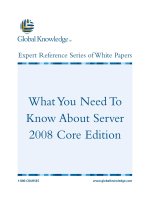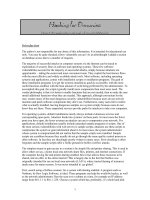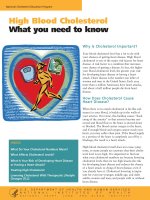Speed Reading For Dummies
Bạn đang xem bản rút gọn của tài liệu. Xem và tải ngay bản đầy đủ của tài liệu tại đây (12.94 MB, 292 trang )
01_457443-ffirs.indd iv01_457443-ffirs.indd iv 6/23/09 8:33:16 PM6/23/09 8:33:16 PM
Speed Reading
FOR
DUMmIES
‰
by Richard Sutz
with Peter Weverka
01_457443-ffirs.indd i01_457443-ffirs.indd i 6/23/09 8:33:16 PM6/23/09 8:33:16 PM
Speed Reading For Dummies
®
Published by
Wiley Publishing, Inc.
111 River St.
Hoboken, NJ 07030-5774
www.wiley.com
Copyright © 2009 by Wiley Publishing, Inc., Indianapolis, Indiana
Published by Wiley Publishing, Inc., Indianapolis, Indiana
Published simultaneously in Canada
No part of this publication may be reproduced, stored in a retrieval system or transmitted in any form or
by any means, electronic, mechanical, photocopying, recording, scanning or otherwise, except as permit-
ted under Sections 107 or 108 of the 1976 United States Copyright Act, without either the prior written per-
mission of the Publisher, or authorization through payment of the appropriate per-copy fee to the
Copyright Clearance Center, 222 Rosewood Drive, Danvers, MA 01923, (978) 750-8400, fax (978) 646-8600.
Requests to the Publisher for permission should be addressed to the Permissions Department, John Wiley
& Sons, Inc., 111 River Street, Hoboken, NJ 07030, (201) 748-6011, fax (201) 748-6008, or online at
http://
www.wiley.com/go/permissions
.
Trademarks: Wiley, the Wiley Publishing logo, For Dummies, the Dummies Man logo, A Reference for the
Rest of Us!, The Dummies Way, Dummies Daily, The Fun and Easy Way, Dummies.com, Making Everything
Easier, and related trade dress are trademarks or registered trademarks of John Wiley & Sons, Inc. and/or
its affiliates in the United States and other countries, and may not be used without written permission. All
other trademarks are the property of their respective owners. Wiley Publishing, Inc., is not associated with
any product or vendor mentioned in this book.
LIMIT OF LIABILITY/DISCLAIMER OF WARRANTY: THE PUBLISHER AND THE AUTHOR MAKE NO
REPRESENTATIONS OR WARRANTIES WITH RESPECT TO THE ACCURACY OR COMPLETENESS OF
THE CONTENTS OF THIS WORK AND SPECIFICALLY DISCLAIM ALL WARRANTIES, INCLUDING WITH-
OUT LIMITATION WARRANTIES OF FITNESS FOR A PARTICULAR PURPOSE. NO WARRANTY MAY BE
CREATED OR EXTENDED BY SALES OR PROMOTIONAL MATERIALS. THE ADVICE AND STRATEGIES
CONTAINED HEREIN MAY NOT BE SUITABLE FOR EVERY SITUATION. THIS WORK IS SOLD WITH THE
UNDERSTANDING THAT THE PUBLISHER IS NOT ENGAGED IN RENDERING LEGAL, ACCOUNTING, OR
OTHER PROFESSIONAL SERVICES. IF PROFESSIONAL ASSISTANCE IS REQUIRED, THE SERVICES OF A
COMPETENT PROFESSIONAL PERSON SHOULD BE SOUGHT. NEITHER THE PUBLISHER NOR THE
AUTHOR SHALL BE LIABLE FOR DAMAGES ARISING HEREFROM. THE FACT THAT AN ORGANIZA-
TION OR WEBSITE IS REFERRED TO IN THIS WORK AS A CITATION AND/OR A POTENTIAL SOURCE
OF FURTHER INFORMATION DOES NOT MEAN THAT THE AUTHOR OR THE PUBLISHER ENDORSES
THE INFORMATION THE ORGANIZATION OR WEBSITE MAY PROVIDE OR RECOMMENDATIONS IT
MAY MAKE. FURTHER, READERS SHOULD BE AWARE THAT INTERNET WEBSITES LISTED IN THIS
WORK MAY HAVE CHANGED OR DISAPPEARED BETWEEN WHEN THIS WORK WAS WRITTEN AND
WHEN IT IS READ.
For general information on our other products and services, please contact our Customer Care Department
within the U.S. at 877-762-2974, outside the U.S. at 317-572-3993, or fax 317-572-4002.
For technical support, please visit
www.wiley.com/techsupport.
Wiley also publishes its books in a variety of electronic formats. Some content that appears in print may
not be available in electronic books.
Library of Congress Control Number: 2009928739
ISBN: 978-0-470-45744-3
Manufactured in the United States of America
10 9 8 7 6 5 4 3 2 1
01_457443-ffirs.indd ii01_457443-ffirs.indd ii 6/23/09 8:33:16 PM6/23/09 8:33:16 PM
About the Authors
Richard Sutz is founder of The Literacy Company. The company’s
software, The Reader’s Edge, is the result of more than $3 million of
research and development. Richard began his involvement in speed
reading more than 30 years ago as a consultant to and a personal
friend of Evelyn Wood, the speed-reading pioneer. His background
and experience span executive roles in both the private and public
sector. Richard was Grumman Aircraft’s Assistant Director for
Europe and the Middle East. In the late 1970s, he was appointed
Deputy Director of the Arizona Energy Office and later joined the
U.S. Department of Energy as director of the Energy Related
Inventions Program.
Peter Weverka is the author of many For Dummies books, including
Office 2007 All-in-One Desk Reference For Dummies. His articles and
stories have appeared in Harper’s, SPY, and other magazines.
01_457443-ffirs.indd iii01_457443-ffirs.indd iii 6/23/09 8:33:16 PM6/23/09 8:33:16 PM
01_457443-ffirs.indd iv01_457443-ffirs.indd iv 6/23/09 8:33:16 PM6/23/09 8:33:16 PM
Dedication
This book is dedicated to the pioneers, researchers, teachers, and
entrepreneurs who from 1880 to the present have provided a solid
base upon which to build my company’s innovative, award-winning
program that teaches silent reading fluency. I’m proud to bring
their teachings into the 21st century.
Author’s Acknowledgements
Where to begin? First with my wife, Wink Blair, who has been a
solid rock of support during the years that I’ve spent on my entre-
preneurial ventures. I thank her from the bottom of my heart.
I thank my second family too. My partners in The Literacy Company
(TLC): Rich Coppola, the co-developer of TLC’s technology, and
Lance Leishman, TLC’s Operations Manager, ran the company while
I was engaged in researching and writing this book.
A special thanks goes to Wiley Publishing for giving me the oppor-
tunity to present what I believe will be a road map to change the
nation’s reading curriculum. I want to thank Michael Lewis for his
support and for understanding that there is a world of difference
between subject matter knowledge, which I do have, and the ability
to write a For Dummies book, which I do not have. Michael arranged
for me to have the very best professional writer, Peter Weverka,
work with me. Without Peter’s partnership, this book could not
have been written. Also at Wiley, I want to thank Alissa Schwipps
and Megan Knoll. It’s incredibly eye-opening to observe the enor-
mous improvements made by professional editing. I take my hat off
to them.
I also want to thank Bill Cowles of SkillPath Seminars and Tom
Hopkins International for being early adopters of silent reading
instruction as taught by The Reader’s Edge. I thank the thousands
of individuals, schools, colleges, universities, and corporations in
99 countries who now use The Reader’s Edge to learn efficient and
effective speed-reading skills.
Finally, I want to thank Harvey Mackay, Tom Hopkins, Rogers
Historical Museum, and StrugglingReaders.com for permitting me
to use their columns and essays in this book as reading selections.
I thank Evan Islam for his list of Fortune Cookies Sayings and
Idiomsite.com and UsingEnglish.com for their list of idioms. I also
thank Howard Bailey for permitting me to use the Recognition and
Motility Eye exercises in this book.
01_457443-ffirs.indd v01_457443-ffirs.indd v 6/23/09 8:33:16 PM6/23/09 8:33:16 PM
Publisher’s Acknowledgments
We’re proud of this book; please send us your comments through our Dummies online registra-
tion form located at . For other comments, please contact
our Customer Care Department within the U.S. at 877-762-2974, outside the U.S. at 317-572-3993,
or fax 317-572-4002.
Some of the people who helped bring this book to market include the following:
Acquisitions, Editorial, and Media
Development
Senior Project Editor: Alissa Schwipps
Acquisitions Editor: Michael Lewis
Copy Editor: Megan Knoll
Assistant Editor: Erin Calligan Mooney
Editorial Program Coordinator: Joe Niesen
Technical Editor: Ed Caldwell
Senior Editorial Manager: Jennifer Ehrlich
Editorial Assistants: Jennette ElNaggar,
David Lutton
Cover Photo: Walter B. McKenzie
Cartoons: Rich Tennant
(www.the5thwave.com)
Composition Services
Project Coordinator: Lynsey Stanford
Layout and Graphics: Reuben W. Davis,
Christine Williams, Erin Zeltner
Proofreader: Jennifer Theriot
Indexer: Potomac Indexing, LLC
Publishing and Editorial for Consumer Dummies
Diane Graves Steele, Vice President and Publisher, Consumer Dummies
Kristin Ferguson-Wagstaffe, Product Development Director, Consumer Dummies
Ensley Eikenburg, Associate Publisher, Travel
Kelly Regan, Editorial Director, Travel
Publishing for Technology Dummies
Andy Cummings, Vice President and Publisher, Dummies Technology/General User
Composition Services
Debbie Stailey, Director of Composition Services
01_457443-ffirs.indd vi01_457443-ffirs.indd vi 6/23/09 8:33:16 PM6/23/09 8:33:16 PM
Contents at a Glance
Introduction 1
Part I: Introducing Speed Reading 7
Chapter 1: Of Course You Can Speed Read! 9
Chapter 2: It’s All about Breaking Bad Reading Habits 23
Chapter 3: Understanding the Mechanics of Speed Reading 35
Chapter 4: Introducing Speed-Reading Fundamentals 49
Part II: Focusing on the Fundamentals 73
Chapter 5: Establishing Your Reading Rate 75
Chapter 6: Taking in More than One Word at a Time:
Reading in Clumps 85
Chapter 7: Getting the Gist from Word Groups 105
Part III: Advancing Your Speed-Reading Skills 125
Chapter 8: Building Your Speed-Reading Momentum 127
Chapter 9: Exercising Your Ability to Read More
in Even Less Time 147
Chapter 10: Other Reading Strategies to Supplement
Your Speed Reading 165
Chapter 11: Taking Advantage of Writing Structure
to Read More Quickly 187
Part IV: Improving Your Comprehension 199
Chapter 12: Expanding Your Vocabulary to Become
a Better Speed Reader 201
Chapter 13: Applying Speed Reading to Various Reading Tasks 221
Part V: The Part of Tens 229
Chapter 14: Ten Quick Techniques to Improve
Your Reading Speed 231
Chapter 15: Ten Exercises for Keeping Your Eyes
Speed-Reading Ready 235
Chapter 16: Ten Tips for Making Your Speed-Reading
Skills Permanent 241
Part VI: Appendixes 245
Appendix A: Uncovering the Prime Words 247
Appendix B: Your Speed-Reading Progress Worksheet 255
Index 261
02_457443-ftoc.indd vii02_457443-ftoc.indd vii 6/23/09 8:33:52 PM6/23/09 8:33:52 PM
Table of Contents
Introduction 1
Part I: Introducing Speed Reading 7
Chapter 1: Of Course You Can Speed Read! . . . . . . . . . . .9
What Is Speed Reading, Anyway? 10
Speed reading is seeing 10
Speed reading is silent reading 11
Speed reading is decoding the words 11
Speed reading is comprehending 12
Speed reading is concentrating 13
Debunking Speed-Reading Myths 14
What You Need to Get Started 14
Proving You Can Read Faster 15
Chapter 2: It’s All about Breaking
Bad Reading Habits . . . . . . . . . . . . . . . . . . . . . . . . . . . .23
Understanding Vocalization and Its Effects 23
Finding out why vocalizing slows you down 24
Finding out how (and how much) you vocalize 25
Getting Away from Vocalization 26
Reading for meaning rather than sound 27
Stopping the vocalization motor 27
Silencing your inner reading voice 28
Exercising to quiet your inner reader 28
Preventing Regression When You Read 33
Chapter 3: Understanding the Mechanics
of Speed Reading . . . . . . . . . . . . . . . . . . . . . . . . . . . . . .35
Fixating on Eye Fixations 35
Looking at eye fixations 36
Eye fixations and reading speed 37
Exercising Your Eye Fixations 39
Comprehending Comprehension Mechanics 45
Reading and your short-term memory 45
Assimilating concepts and ideas 46
Exploring the Pacer Question 46
Deciding How Much to Bring to Your Reading 48
02_457443-ftoc.indd viii02_457443-ftoc.indd viii 6/23/09 8:33:52 PM6/23/09 8:33:52 PM
Table of Contents
ix
Chapter 4: Introducing Speed-Reading
Fundamentals . . . . . . . . . . . . . . . . . . . . . . . . . . . . . . . . .49
Widening Your Vision Span 49
Reading Clump by Clump 53
Reading Vertically as Well as Horizontally 54
Working with Word Groups 58
Grasping word groups as you read 58
Getting the knack for spotting word groups 62
Taking On Continuous Text 64
Getting Into the Speed-Reading Mindset 69
Part II: Focusing on the Fundamentals 73
Chapter 5: Establishing Your Reading Rate . . . . . . . . . .75
How the Experts Test Speed-Reading Rates 75
Words per minute (WPM) testing 76
Effective reading rate (ERR) testing 76
Establishing Your Base Reading Rate 77
Seeing Where You Stand as a Speed Reader 83
Chapter 6: Taking in More than One Word
at a Time: Reading in Clumps . . . . . . . . . . . . . . . . . . . .85
What Is a Clump, Anyway? 85
Comprehending Clump-Reading Mechanics 89
Macular and peripheral vision 90
Reading with your peripheral vision too 90
Recognizing images as words 93
Making the Shift to Clump Reading 95
Changing your relationship to words
on the page 96
Widening your reading vision 96
Reading in context 96
Getting More Practice Reading in Clumps 97
Reading clump phrases 97
Reading sentence clumps 100
Widening your vision: Reading horizontal
and vertical clumps 101
Chapter 7: Getting the Gist from Word Groups. . . . . . .105
Going Beyond Clumps to Word Groups 105
Recognizing Word Groups 107
Getting the idea from idioms 107
Understanding word groups through idioms 108
02_457443-ftoc.indd ix02_457443-ftoc.indd ix 6/23/09 8:33:52 PM6/23/09 8:33:52 PM
Speed Reading For Dummies
x
Picking out prepositional phrases 112
Taking in larger word groups: Reading phrases 113
Finding other key phrases 118
Identifying the Most Important Word Groups:
Thought Units 119
Reading Word Groups to Increase Comprehension 119
Part III: Advancing Your Speed-Reading Skills 125
Chapter 8: Building Your Speed-Reading
Momentum . . . . . . . . . . . . . . . . . . . . . . . . . . . . . . . . . . .127
Reading Text in Narrow Column Clumps 127
Reading Clump Text in Wider Columns 133
Identifying Word Groups in Continuous Text 139
Reading Word Groups in Continuous Text 143
Chapter 9: Exercising Your Ability to Read More
in Even Less Time . . . . . . . . . . . . . . . . . . . . . . . . . . . . .147
Introducing Push-Down and Push-Up Exercises 147
Getting More from What You Read:
Push-Down Exercises 148
Focusing on your silent reading 148
Spreading your vision span even wider 152
Advancing Your Reading Limit: Push-Up Exercises 156
Reading aggressively without regressing 156
Improving your concentration 160
Chapter 10: Other Reading Strategies
to Supplement Your Speed Reading . . . . . . . . . . . . .165
Comparing Other Ways to Collect Info from Text 165
Skimming for the main ideas 166
Scanning for specific words or phrases 166
Prereading to find out what the text is about 167
Discovering the Art of Skimming 167
Knowing when to skim 168
Grasping skimming techniques 169
Practicing skimming techniques 171
Scanning for the Information You Need 173
Getting the hang of scanning 173
Exercising your scanning skills 174
Prereading to Get the Lay of the Land 176
Sizing up the reading material 176
Getting some prereading practice 177
Postreading to Reinforce What You Read 185
02_457443-ftoc.indd x02_457443-ftoc.indd x 6/23/09 8:33:52 PM6/23/09 8:33:52 PM
Table of Contents
xi
Chapter 11: Taking Advantage of Writing Structure
to Read More Quickly . . . . . . . . . . . . . . . . . . . . . . . . .187
Getting to the Main Idea in a Paragraph
with Topic Sentences 188
Understanding topic sentences 188
Locating the topic sentence 189
Thinking Like the Author 190
Taking knowledge level into account 190
Paying attention to structure 190
Looking Out for Signal Words 192
Contrast signals 193
Comparison signals 193
Example signals 194
Additional argument signals 194
Causation signals 195
Conclusion signals 195
Recognizing and Skipping Subordinate Clauses 196
Part IV: Improving Your Comprehension 199
Chapter 12: Expanding Your Vocabulary
to Become a Better Speed Reader . . . . . . . . . . . . . .201
Understanding How Your Vocabulary Expands 201
Discovering vocabulary words by meaning 202
Discovering vocabulary words by context 203
Looking at Prefixes, Roots, and Suffixes 204
Peeking at prefixes 205
Getting to the root of roots 207
Searching out suffixes 217
Chapter 13: Applying Speed Reading
to Various Reading Tasks . . . . . . . . . . . . . . . . . . . . . .221
Speed Reading the Newspaper 221
Managing Online Articles 223
Handling E-mail Correspondence 224
Prereading Nonfiction Books 225
Tackling Textbooks 226
Speed Reading Standardized Tests 227
Reading for Pleasure 228
Part V: The Part of Tens 229
Chapter 14: Ten Quick Techniques to Improve
Your Reading Speed . . . . . . . . . . . . . . . . . . . . . . . . . . .231
Make the Speed-Reading Commitment 231
Focus Like a Laser Beam 231
02_457443-ftoc.indd xi02_457443-ftoc.indd xi 6/23/09 8:33:53 PM6/23/09 8:33:53 PM
Speed Reading For Dummies
xii
See It, Don’t Say It 232
Resist the Regression Urge 232
Widen Your Vision Span 232
Preread It 233
Vary Your Reading Rate 233
Read for the Main Ideas 233
Use the Eye Sweep 234
Get Your Eyes Checked 234
Chapter 15: Ten Exercises for Keeping
Your Eyes Speed-Reading Ready . . . . . . . . . . . . . . . .235
Eye Squeezes 235
Thumb-to-Thumb Glancing 236
Tree Pose 236
Eye Rolling 237
Eye Writing 237
The 10-10-10 238
Change of Focus 238
Palming 239
Hooded Eyes 239
Eye Massage 240
Chapter 16:Ten Tips for Making Your
Speed-Reading Skills Permanent . . . . . . . . . . . . . . .241
Renew Your Commitment 241
Expand Your Reading Vision 242
Shush Your Inner Reading Voice 242
Read More Often 242
Be a Goal-Oriented Reader 243
Enlarge Your Vocabulary 243
Be a Strategic Reader 243
Occasionally Time Yourself 244
Do Your Exercises 244
Visit the Optometrist 244
Part VI: Appendixes 245
Appendix A: Uncovering the Prime Words . . . . . . . . . .247
Appendix B: Your Speed-Reading
Progress Worksheet . . . . . . . . . . . . . . . . . . . . . . . . . . .255
Index 261
02_457443-ftoc.indd xii02_457443-ftoc.indd xii 6/23/09 8:33:53 PM6/23/09 8:33:53 PM
Introduction
N
o matter how quickly or slowly you read now, you can read
much more rapidly by adopting the speed-reading techniques
described in this book. You can also comprehend, retain, and recall
what you read much more successfully. You can become an efficient
and effective reader, one who reads with confidence and greater
understanding. You can read more in the time you devote to reading
and get more from the articles and books you read.
This book represents all that I know and have discovered about
speed reading during my 40 years as a speed-reading instructor and
developer of speed-reading software. I have had the great pleasure
of seeing my students’ reading speeds and comprehension improve
dramatically, and I have also seen them derive greater pleasure from
reading. These goals — increasing your reading speed and your
pleasure from reading — are what this book is all about.
About This Book
The science (some would say art) of speed reading is about 100
years old. Consequently, theories abound as to what makes a good
speed reader and how to become a speed reader. This book takes
a very basic approach to the subject — I believe speed reading is
efficient reading. You don’t have to be a wizard or master arcane
techniques to be a speed reader. All you have to do is understand
the mechanics of reading and then apply yourself more efficiently
to exercising those mechanics when you read. This book shows
you how to do that.
Speed Reading For Dummies is for people who have little or no
background in speed reading, as well as for experienced speed
readers who want to hone their speed-reading skills. It offers
many strategies, tips, and tricks to improve your reading speed
and includes numerous exercises to give you hands-on practice
in speed-reading techniques. It also explains the how and why of
speed-reading mechanics so that you understand not just what to
do when you speed read but also why you do it.
A note about the exercises: If at first you don’t succeed, try again.
Everyone grasps new material at a different rate — don’t get dis-
couraged if you don’t do as well as you expect the first time out of
the gate. You can apply these exercises to just about any reading
03_457443-intro.indd 103_457443-intro.indd 1 6/23/09 8:34:06 PM6/23/09 8:34:06 PM
Speed Reading For Dummies
2
material to get additional practice; as I mention elsewhere in this
book, newspapers are perfect for speed-reading practice, so con-
sider starting there.
You don’t have to read this book from start to finish — unless you
want to, of course. I wrote and organized Speed Reading For Dummies
so that you can start reading it anywhere you want. Consult the table
of contents or “How This Book Is Organized” later in this introduction
to find the speed-reading topic that interests you.
Conventions Used in This Book
To make this book easier to read, I’ve adopted these conventions:
✓ I italicize new terms in the text the first time I introduce
them and then follow them closely with an easy-to-understand
definition.
✓ Steps in the exercises are numbered and appear in boldface text.
Follow the boldface instructions to complete the exercises.
✓ Web addresses appear in
monofont.
✓ Though many use the term vocalization to mean “reading
aloud,” for the purposes of this book I define vocalization as
“speaking or hearing words as you read them.”
✓ Some exercises include long text pieces for you to practice on.
I label these pieces to correspond with the exercise number
(so Practice Text 7-1 goes with Exercise 7-1). For exercises
that have multiple text pieces (such as those that ask you
to read the same essay in different formats), I add a letter to
each Practice Text heading (for example, Practice Text 2-1a
and Practice Text 2-1b).
What You’re Not to Read
I’ve written this book so you can find the information you need
easily and quickly. All the chapters provide you with important
information, but the sidebars offer greater detail or tidbits of infor-
mation that you can skip if you like. I encourage you to read this
information along with the regular text, but if you want to focus
on the main points of the chapters, you can always come back to
these shaded sections another time.
03_457443-intro.indd 203_457443-intro.indd 2 6/23/09 8:34:07 PM6/23/09 8:34:07 PM
Introduction
3
Foolish Assumptions
Forgive me, but I’ve made a few foolish assumptions about you, the
reader of this book. I assume the following:
✓ You want to read anything and everything more quickly.
✓ You want to better comprehend and retain the books, articles,
and Web pages you read every day.
✓ You feel overwhelmed by the amount of info you have to read
for work or school and want a way to quickly and effectively
get through all of it.
✓ You’ve heard a few tidbits about speed reading and are
intrigued by the topic or wonder whether what you’ve heard
is true.
✓ You want a plainspoken guide that trains you to speed read
without a lot of fuss so you can quickly master speed-reading
techniques.
How This Book Is Organized
Following is a short summary of each part of Speed Reading For
Dummies. I invite you to use this summary as a quick guide to
speed reading topics that interest you. Choose the speed-reading
topic that interests you and have at it.
Part I: Introducing Speed Reading
Part I lays the groundwork for understanding what speed
reading is and how you can read more efficiently. Chapter 1
explains what happens in your brain and other parts of your
anatomy when you speed read and the skills you need to be a
speed reader. Chapter 2 delves into two bad habits — vocalizing
and regressing — that keep you from reading quickly and then
shows you how to break these habits. In Chapter 3, I look into
eye fixations, vision span, and other reading mechanics to help
you understand how to be a speed reader. Chapter 4 offers a
number of speed reading exercises to give you a sense of the
different skills you need to develop (and can develop with the
exercises in Part II).
03_457443-intro.indd 303_457443-intro.indd 3 6/23/09 8:34:07 PM6/23/09 8:34:07 PM
Speed Reading For Dummies
4
Part II: Focusing on the
Fundamentals
Part II explores the core fundamentals of speed reading. First,
Chapter 5 gives you an opportunity to take your first speed-reading
tests so that you know where you stand. Then in Chapter 6 you
take your first steps down the road to reading more than one word
at a time as you discover how to widen your vision span vertically
and horizontally when you read. Chapter 7 gives you practice
in reading for units of meaning so that you read not only more
than one word at a time but also one entire thought at a time and
increase your comprehension, retention, and recall.
Part III: Advancing Your
Speed-Reading Skills
Part III takes you to a higher speed-reading realm. To reinforce your
speed-reading skills, Chapter 8 offers exercises that have you read
text in ever wider columns so you can challenge your ability to read
more words per eye fixation. Chapter 9 presents techniques to help
you read aggressively with heightened concentration. In Chapter 10,
you go above and beyond the normal speed-reading skills — this
chapter explains how to skim, scan, and preread. Chapter 11 explains
some refined speed-reading skills, including how to recognize the
essence of a paragraph, follow the author’s thought patterns, and
skip subordinate clauses in your reading.
Part IV: Improving Your
Comprehension
Part IV looks at how to improve your comprehension, retention, and
recall. Because having a large vocabulary is essential to being a speed
reader, Chapter 12 shows how to expand your vocabulary. Chapter 13
explores a potpourri of speed-reading tasks, including encouraging
children to speed read; speed reading standardized tests, textbooks,
and newspapers; and increasing your reading pleasure.
Part V: The Part of Tens
Each of the chapters in Part V offers advice for being a better speed
reader. Chapter 14 offers quick tips for improving your speed read-
ing. Chapter 15 presents eye exercises for expanding your reading
vision and seeing after your eye health, and Chapter 16 shows you
how to make your speed reading skills permanent.
03_457443-intro.indd 403_457443-intro.indd 4 6/23/09 8:34:07 PM6/23/09 8:34:07 PM
Introduction
5
Part VI: Appendixes
You thought you were done, right? Not so fast — Part VI offers two
appendixes. Appendix A lists the 2,000 most common words in the
English language so you can be sure you know these all-important
words. Appendix B provides a worksheet to help you track your
progress on various exercises in this book.
Icons Used in This Book
To help you get the most out of this book, I’ve placed icons here
and there. Here’s what the icons mean:
Next to the Tip icon, you find tricks of the trade designed to make
you a better speed reader.
Where you see the Warning icon, tread carefully: These icons alert
you to common speed-reading mistakes and errors.
Remember icons mark juicy facts that bear remembering. When
you see this icon, prick up your ears.
Where to Go from Here
Where should you start reading? Anywhere your curiosity takes
you. However, a couple of good starting points are Chapter 2, which
describes bad reading habits you must overcome to be a speed
reader, and Chapter 3, which looks at the mechanics of speed reading.
Wherever you start, good luck in your speed-reading adventures!
03_457443-intro.indd 503_457443-intro.indd 5 6/23/09 8:34:07 PM6/23/09 8:34:07 PM
Speed Reading For Dummies
6
03_457443-intro.indd 603_457443-intro.indd 6 6/23/09 8:34:07 PM6/23/09 8:34:07 PM
Part I
Introducing Speed
Reading
04_457443-pt01.indd 704_457443-pt01.indd 7 6/23/09 8:34:35 PM6/23/09 8:34:35 PM
In this part
W
ith the idea that you should look before you leap,
Part I provides a general introduction to speed
reading. These chapters explain what goes on in your
mind and body during the act of speed reading, what skills
every speed reader needs, and which bad reading habits
you need to break if you want to be a speed reader.
If you’re new to speed reading, I suggest reading all of Part I,
especially Chapter 1, which describes the anatomy of read-
ing, and Chapter 2, which explains why vocalization is a
hindrance to fast reading and how to break the vocalization
habit. Chapter 3 shows how to expand your vision and take
in several words at once in the act of reading. Visit Chapter 4
to get a taste of the different skills you need to acquire to
become a speed reader.
04_457443-pt01.indd 804_457443-pt01.indd 8 6/23/09 8:34:36 PM6/23/09 8:34:36 PM
Chapter 1
Of Course You Can
Speed Read!
In This Chapter
▶ Understanding the act of reading
▶ Examining speed-reading myths
▶ Finding the right spot for successful speed reading
▶ Demonstrating to yourself that you can speed read
I
f you’re a typical reader, your reading education ended in the
third grade, and you currently read using the same techniques
you used as a third grader. You’re not reading as fast as you want
because no one taught you the skills to read faster.
That’s the bad news.
The good news is that everybody can increase their reading speed
by adopting a few simple techniques. Beyond those techniques, by
being a committed reader, applying speed-reading principles, and
reading with more concentration, you can read very quickly —
perhaps doubling or even tripling your current reading speed. You
can also read with better comprehension and retain and recall what
you read. What’s more, you can get more pleasure and meaning
from the books, articles, and Web pages you read.
This chapter introduces basic speed-reading concepts and demon-
strates why anyone can become a speed reader. At the end of the
chapter, you can find an exercise that lets you put speed-reading
skills to the test and see for yourself just how helpful a few tech-
niques can be.
05_457443-ch01.indd 905_457443-ch01.indd 9 6/23/09 8:35:11 PM6/23/09 8:35:11 PM
Part I: Introducing Speed Reading
10
What Is Speed Reading, Anyway?
When you read the words on the page of a book or newspaper
article, what goes on in your head? Do you also hear the words as
you read them? If you do, someone is speaking them, and unless a
leprechaun is sitting on your shoulder, that someone is you.
Reading engages the eyes, ears, mouth, and, of course, the brain.
Speed reading engages these senses even more than normal read-
ing because you use your senses and brain power even more
efficiently. The following sections explain in detail what goes on in
your eyes, ears, mouth, and brain when you speed read.
Speed reading is seeing
First and foremost, speed reading is seeing; the first step in read-
ing anything is seeing the words. But how do you see words on the
page when you read?
Prior to 1920 or so, researchers and educators believed that
people read one word at a time. To read, they thought, you moved
your eyes left to right across the page, taking in one word after the
other. Under this theory, fast readers were people who could iden-
tify and recognize the words faster.
However, all but beginning readers have the ability to see and read
more than one word at a time. As you move your eyes left to right
across the page, you jump ahead in fits and starts, taking in any-
where between one and five words at a time in quick glances.
These quick glances, when your eyes stop moving at different
points in a sentence as you read it, are called eye fixations. I get
into more detail on how eye fixations work in Chapter 3, but for
now, the important points to know about speed reading are
✓ You read several words in a single glance. Unless you’re
encountering words you don’t know or haven’t read before,
you don’t read words one at a time.
✓ You expand your vision so that you can read and understand
many words in a single glance. A very good speed reader can
read, see, and process 10 to 14 words in a single eye fixation.
✓ You expand your vision to read vertically as well as horizon-
tally on the page. As well as taking in more than one word on a
line of text, speed readers can also, in a single glance, read and
understand words on two or three different lines. Check out
Chapter 6 for more on expanding your reading vision, and head
to Chapter 15 for some exercises that help you do just that.
05_457443-ch01.indd 1005_457443-ch01.indd 10 6/23/09 8:35:11 PM6/23/09 8:35:11 PM
Chapter 1: Of Course You Can Speed Read!
11
Speed reading is silent reading
When you read, do you sometimes hear a faint whispering in your
ear that belongs not to you, but to another person? Don’t fret,
because you aren’t alone. Most people hear words when they read.
The words speak to them from the page.
When you read, you speak words to yourself because you learned
to read with the sound-it-out method. In school, your teacher told
you that each letter makes a sound (sometimes more than one
sound), that certain letter combinations also make sounds, and
that you can always read a word by sounding out the letters and
letter combinations:
su-per-cal-i-frag-il-ist-ic-ex-pi-al-i-do-cious
Your teacher was absolutely right. Being able to sound out words
is an essential skill for beginning readers. Knowing the sounds
each letter makes and knowing what sounds letter combinations
make enables you to pronounce and read any word you encounter
in your reading.
The problem with the sound-it-out approach to reading is that it
slows you down. You read not at the speed you think but rather
at the speed you talk. Sounding it out is fine for beginning readers,
but at some point you have to dispense with sound if you want
to be a speed reader. Saying the words, even if you only whisper
them inside the confines of your skull, takes time.
In speed-reading terminology, saying and hearing words as you
read them is called vocalizing (Chapter 2 gives you the lowdown
on vocalizing and how to stop it). For now you need to remember
that
✓ Vocalizing is a throwback to your early reading education;
you must abandon it to be a speed reader.
✓ Training yourself not to vocalize when you read is one of the
most important speed-reading skills you can acquire.
Speed reading is decoding the words
When you come across a word in your reading that you don’t know
or recognize, you have to decode it. You break it into syllables, try
to pronounce it, and see whether it’s related to words you know.
You try to get its meaning, and if you can’t do that on your own,
you consult a dictionary or other reference source.
05_457443-ch01.indd 1105_457443-ch01.indd 11 6/23/09 8:35:11 PM6/23/09 8:35:11 PM









